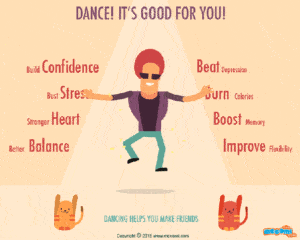Dancing is a physical activity that exerts a number of beneficial effects on the human body, mind, and soul. Now , the question to be asked is, in what manner does a dance style/form positively affect a human being? The answer to this question lies in two scientific studies published in 2013, which suggests that the the functioning of the brain improves when an individual performs a dance style. So, here is then providing you with a detailed analysis explaining ‘how performing a dance style benefits the brain’.

a. Dancing and its correlation with body balance maintenance?
Have you ever felt dizzy while standing up? If the answer to this question is yes, then dance (according to a study) is the solution to this problem. As per research conducted by the Imperial College London in September 2013, performing a dance helps you in maintaining body balance by enabling the proper fusion of cerebral and cognitive thought processes . Furthermore, according to a scientific article titled ‘The Neuroanatomical Correlates of Training-Related Perceptuo-Reflex Uncoupling in Dancers’, it is dancing over a number of years that helps suppress signals radiating from the balance organs located in the inner ear and linked to the cerebellum. It is the suppression of these signals that eventually helps an individual maintain proper body balance and avoid dizziness. In fact, according to the journal ‘Cerebral Cortex‘, performing a dance form on a regular basis could help individuals suffering from chronic dizziness.
b. The relation between Muscle Memory and Dancing:
According to the ‘Psychological Science’ Journal, there is a direct link between muscle memory and dancing. A report in this journal suggests that, the performer after years of performing is able to ‘memorize’ and ‘replicate’ steps, which is scientifically termed a ‘muscle memory’. In addition, it is this type of memory that enables the dancer to perform extremely smoothly, and creates a movement known as ‘superfluidity’. Furthermore, this memory also exerts less stress on the brain (mind) of the dancer while performing.
c. The ‘Cerebral and Cerebellum Connection’ with regards to Dancing:
After observing results of a few studies published in some journals (mentioned above) across the world, it is clearly evident that the fusing of the cerebral cognitive function with the muscle memory stored in the cerebellum while the performer is dancing, is what helps the performance hit its peak. Additionally, it also helps to ensure that performers maintain a good body balance, and avoid dizziness.
With scientific studies confirming the fact that dancing does have a positive effect on the human brain, it certainly seems that dance is not just a part of human society but ‘a way of life’ as well.
Image Credits: Quora and NoHo Arts District
